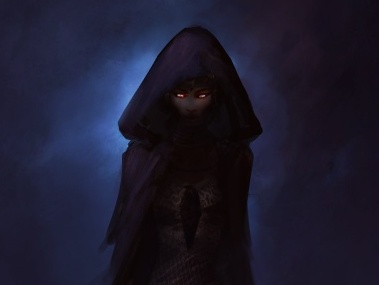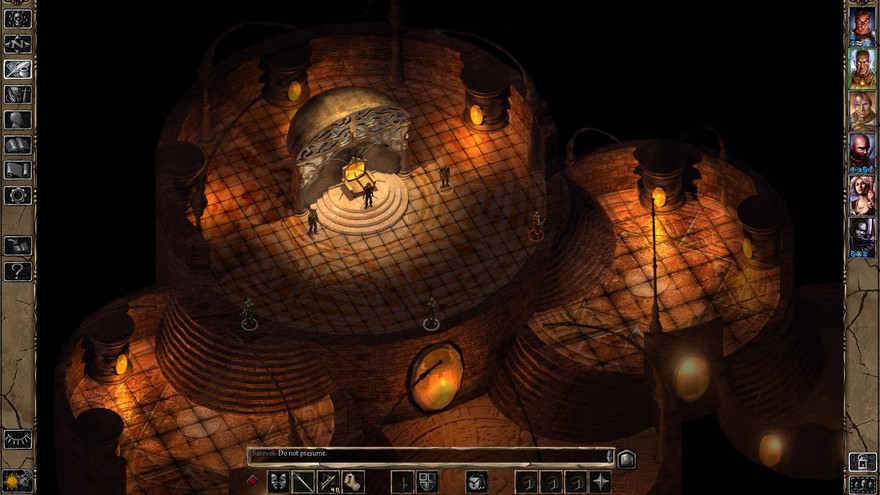The dungeons of Baldur’s Gate 2 have yet to be plundered. Inside its halls, goblins await a band of heroes. The keys to the library sit in the second sewer tunnel, directly behind a black cauldron. An NPC Golem sits inside of a laboratory, not yet fooled into leading me inside his master’s crypt. And in the middle of all this, I pray for vindication and satisfaction. Because this has been a pretty damn dull experience.
I felt one thing within the ten hours that I played of Baldur’s Gate 2: Enhanced Edition: frustration. Bitter, difficult, and unrelenting frustration. I’m a huge fan of getting nostalgic, especially when it comes to videogames. Sixty hours of turn-based combat in Fire Emblem? No problem. But to really enjoy a game, you need more than passive, inanimate respect for structure and mechanics. It requires a certain nameless excitement. Sometimes, we call it “fun.” But as I sat playing Baldur’s Gate 2 on a borrowed PC from my university’s library, I couldn’t grasp any sort of joy, ecstasy, or insight. Everything felt … outdated. Unprovocative.

In the grand scheme of things, I realize, this does not matter. “English major chooses CliffsNotes over Billy Budd” is not really a headline. But something interesting seems to be at play … let’s take the combat, for example. A total onslaught of magic and swords emerged in front of me, but where was I in this mess? I was a little arrow, hovering above my pixellated team and clicking, clicking, clicking. Minsc, the party’s tank, screamed, “Make way villainy, a hero is coming through!” as we encountered another idiot horde. I shared little of his excitement.
Only thirteen years ago, Baldur’s Gate 2 was considered one of videogames’ greatest achievements. Yet even through a thick, half-feigned veil of historical respect, I couldn’t enjoy Baldur’s Gate 2. Its awards and accolades only add to my confusion. Why isn’t this equation balancing? Or really, at what point is this my fault?

In an article on this site, Ilya Zarembsky asked it in a different way: “What exactly does it mean to preserve a video game?” That article explored a host of opinions from the ivory tower of video game preservation hosted at Pressing Restart, a conference at the NYU Poly Magnet Center in 2013. One idea put forward by Henry Lowood, a curator for Stanford University Libraries, centered around the “fallacy of the executable,” which promotes the preservation of a game’s culture, and not only its particular mechanics or “apparatus.” Zarembsky summarizes: “A game is not just a piece of software, but rather a historically specific site of shared experience.” This kind of thinking takes issue with updating NES or Sega Genesis games for modern emulators, à la Ouya or PSN Classic (they’d probably be a bit suspicious of Baldur’s Gate 2: Enhanced Edition, too). What matters is context. Specific mechanics are simply doomed to fade away, replaced by the next great things of technology.
But this “fallacy,” I suppose, explains a part of my problem with Baldur’s Gate 2: the game came into being at a time where gaming was still largely point-and-click. It was meant for a Compaq PC desktop, not the realm of the richly animated HDMI widescreen TV. Leave the past in the past, millennial. You can’t understand it!
I can’t help but feel frustration with this kind of thinking. Sure, games may possess a context. As do all things! But we certainly don’t bracket past works of art or literature as enclosed, uniquely “old world” experiences. Do you have to be a soldier in the Russian Imperial Army to relate to War and Peace? A member of a marginalized race to appreciate ragtime? No, of course not: human experiences cross boundaries of context and time. We can feel just as passionate about Don Quixote’s idyllic wander through the Spanish countryside as a seventeenth-century fan of King Arthur would have, and just as enraged with society as Joseph Conrad was in Heart of Darkness over a century ago. The pleasure we derive from art, I think, stems from our ability to grasp some of the ideas first imparted into it by its designer. Then, we apply it to our own contexts, deep within the present. Doesn’t matter if it’s Impression: soleil levant or Ocarina of Time. We each encountered what was designed by the artist and deeply felt something.
This way of thinking about game preservation could be on the rise. In late 2012, MoMA acquired EVE Online and placed it on display in its Applied Design exhibit, running from March 2013 to January 2014. And as Adi Robertson explained in his article for The Verge, putting EVE on display was a mechanically thorny event:
More so than film and text, [videogames] are dependent on delicate and sometimes irreplaceable hardware or software platforms that became obsolete long ago. A certain controller or other peripheral may be vital to getting an “authentic” experience.
We’ve essentially run right back into Lowood’s thesis: culture trumps technology. Mechanics are contextually contingent and exclude the truly “human” side of gaming.
This polarity doesn’t really get to the heart of what’s at stake. As MoMA’s design curators decided how to “preserve” EVE Online, they realized the impossibility of precisely recreating a play experience for the museum. Instead, they opted for “future generations to look over [the players’] shoulders,” taking real-time recordings of gamers and situating them in the game’s technical and mechanical contexts. Essentially, they took the latent “culture” of the game—the players and their backgrounds—and measured them up to their choices within the framework of EVE. What strategic choices did they make, what equipment did they use, and how well did they accomplish their goals? MoMA’s design department supervisor put it this way: “If somebody comes out in a hundred years and wants to research this early creation of a virtual world—if you think of this stuff in kind of increasingly dominating our lives and just imagine what it will be like in a hundred years—we’re looking at the genesis of that world … but it’s only helpful if you’ve got some real, tangible quality of that culture available for people to see.”

This is really what I’m harping on. The most crucial way to think back on games is to reflect on their tangible aspects—those of mechanics, structure, and even hardware. We need to grasp how people thought about and discussed games just as much as their literal interaction with a game’s design. All design looks back to what came before. When we encounter structural flaws, we think about how this very design should be improved. As game designer for The Last of Us, Ricky Cambier noted Resident Evil 4 as an important influence on Naughty Dog’s opus. And as I run through the gangs of immaculately rendered zombies, you can’t help but hear the echoes of Capcom’s wonderchild from 2004. The Last of Us isn’t a stand-alone kind of production. It’s one of several games in the long tradition of a genre. Can we still enjoy The Last of Us without RE4? Probably. But what we’d betray is the real heritage of our present, the problems of the distant past that have led to the solutions in design that we witness today.
But what does this do for Baldur’s Gate? Not too much. We can debate whether or not BG2 was a “good” or “bad” game—public opinion will suggest the former, obviously—but I believe that what’s at stake is the right way to think about videogames. I’ve come face-to-face with a wall of awards collecting dust, and it tells me that this game is great and I’m an idiot for thinking otherwise. Perhaps it’s easier at the end of the day to play the “context card” and blissfully reflect on the eclectic ways of the past. Call me a n00b and call it a day.
But I’m still not satisfied. For me, a great game should always feel … great. And if it doesn’t, did all of those awards mean anything? Did our belief in the wave of the future pan out to be anything that we respect today? Perhaps yes, perhaps no. What trumps this endless loop of “good game/bad game,” however, is what we choose to remember from BG2 now, today. Collective memories may change. But now, they tell us how to shape the future. Game mechanics are bound to change, and become altmodische within the span of a few years. But these changes wouldn’t have come to be without our own encounters with what we saw as “bad” or “boring” gaming. Above all, our tastes have decided the future—and to remember that, we have to force ourselves to barrage through the boring, boring dungeons of Baldur’s Gate 2.
